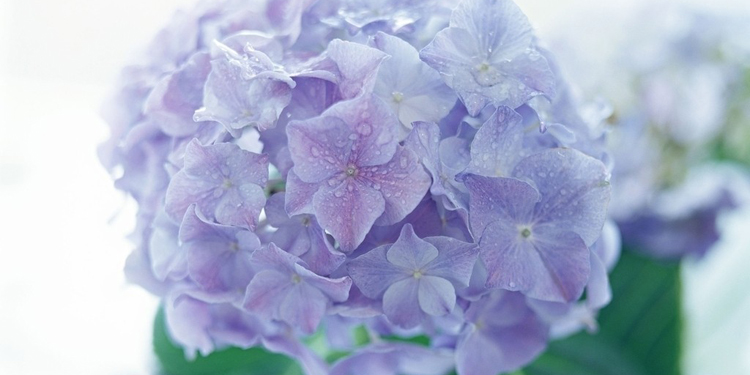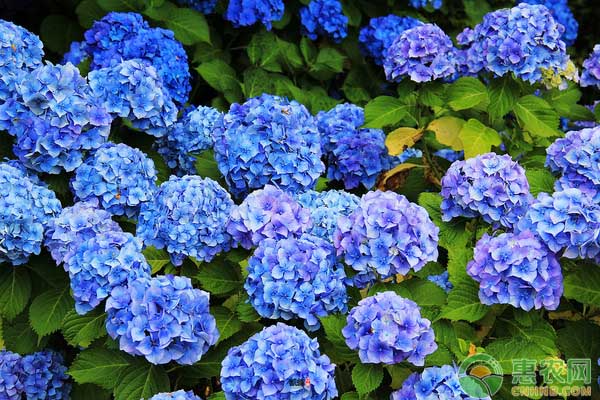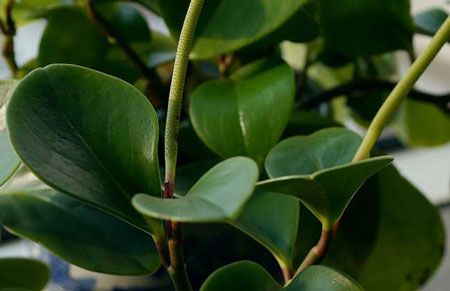Propagation method of Hydrangea
Like a warm, humid and semi-shady environment. It is suitable for slightly clayey soil which is fertile, rich in humus and well drained, and the suitable soil pH value is 4.0-4.5.
1. Methods of reproduction
The main results are as follows: (1) ramet propagation should be carried out before germination in early spring, and the sprouting seedlings in the roots can be separated by changing pots.
(2) the propagation and crimping should be carried out in the rainy period, the biennial branches should be cut in the appropriate place, and wrapped with half-half bamboo tube or film with nutritious soil to maintain the soil moisture, it can take root after one month, and cut off the mother body in the next spring. take the soil block on the basin to plant.
(3) Cuttage propagation can be carried out except in winter. Cutting twigs in early spring, cuttings should have 2-3 nodes, and the lower leaves should be removed to reduce water evaporation. The young lateral branches germinated from the trunk and lateral branches can also be cut from the base in the summer peak season, and the leaves can be inserted into the plain sandy soil and preserved and moisturized in the shade place. the roots can be rooted in about 20 days, and the survival rate is high.
2. During the period of cultivation and management, fertilizer was applied once every 2 to 3 weeks to promote plant growth and flower bud differentiation. The basin soil is often mixed with the same amount of loam, rotten leaf soil or compost soil, and an appropriate amount of river sand is added. At the end of October, the plant was moved into a low-temperature greenhouse, watering was controlled, and the temperature was 3-5 ℃, so that the plant was fully dormant.
Breeding methods and matters needing attention of hydrangea breeding methods of hydrangea
Hydrangea is a very important summer flower and tree, which can be planted everywhere, but if it is planted in places such as windowsill and balcony, it will look interesting at home. What are the breeding methods and matters needing attention of hydrangea? let's learn about it together.

First, the basic information of hydrangea
Hydrangea, also known as eight Immortals, Ziyang Flower, Seven changes, Hydrangea, Noodle Flower, originated in Sichuan, China and Japan. It is a deciduous shrub of the genus Hydrangea (scientific name: Saxifragaceae). The flowers are almost asexual, and the so-called "flowers" are just sepals.
Hydrangea was cultivated earlier in China, and hydrangea was planted in the gardens in the south of the Yangtze River built in the Ming and Qing dynasties. The park built at the beginning of the 20th century is also inseparable from the planting of hydrangea. Modern parks and scenic spots are planted in pieces to form a landscape. Artificially cultivated hydrangea flowers are colorful, with blue, white, purple, pink, pink and other colors, is a common ornamental flowers and trees.
II. Culture methods and matters needing attention of Hydrangea
1. Soil: loose, fertile and well-drained sandy loam is the best soil for hydrangea planting. However, the flower color is affected by soil acidity and alkalinity, acidic soil flowers are blue and alkaline soil flowers are red.
2. Watering: the potted soil planted with hydrangea should be kept moist, but it should not be watered too much, especially in the rainy season to prevent rotting roots caused by waterlogging. It is better to dry indoor potted plants in winter. If it is too wet, the leaves will rot easily.
3. Lighting: Hydrangea is a short-day plant, usually cultivated to avoid the hot sun, 60% to 70% shade is the most ideal. When the light is too strong in midsummer, proper shading can prolong the flowering period.
4. Temperature: the optimum temperature for the growth of hydrangea is 18-28 ℃, and the winter temperature is not lower than 5 ℃. Flower bud differentiation takes 6-8 weeks under the condition of 5-7 ℃. The temperature of 20 ℃ can promote flowering, maintain 16 ℃ after anthesis, prolong the viewing period, and pay attention to the rapid discoloration of flowers caused by high temperature.
5. Fertilization: the flowering period of hydrangea is from June to July, the fertilizer and water should be sufficient during the flowering period, and fertilize once every semimonthly.
6. Pruning: after Hydrangea blossoms, attention should be paid to the removal of flower stems to promote the production of new branches. Proper pruning can keep the plant shape graceful.
7. Insect pests: Hydrangea is mainly caused by wilt, powdery mildew and leaf spot. Spray control with 65% Dysen zinc wettable powder 600 times solution. Insect pests are harmful to aphids and bug bugs and can be sprayed with 1500 times of omethoate EC.
III. Propagation methods of Hydrangea
Cuttings, ramets, striping and grafting are commonly used for propagation, mainly cuttings. During the Meiyu period, strong twigs on young mother trees can be selected as cuttings, with nodes at the base of cuttings, stained with mud, about 20 cm long, and the lower leaves can be removed. The suitable temperature of cutting is 13-18 ℃, shade is needed after cutting, it is often kept moist, rooting takes place in about 15 days to 1 month, and it can be transplanted in the second year after survival. Ramet propagation should be carried out before sprouting in early spring. Separate the rooted branches from the mother plant, pot directly, watering should not be too much, maintain in the semi-shady place, wait for new buds to sprout and then transfer to normal maintenance. Striping propagation can be carried out during bud germination, grow after 30 days, cut off from the mother plant in the following spring, transplant with soil, and blossom in the same year. In general, high pressure is carried out from March to April in spring, and it can take root from June to July, and it can be cut and planted in the same year. Grafting propagation uses Qionghua seedlings as rootstocks, cutting in spring, easy to survive. Transplanting should be carried out after defoliation or before budding. The main branch is easy to sprout and grow, and it needs to be pruned properly after flowering to shape the tree.
Propagation method of Hydrangea
Picture: hydrangea planting
[FAQ] Propagation methods of Hydrangea
[expert answers]
1. Ramet propagation
It should be carried out before sprouting in early spring. Separate the rooted branches from the mother plant, pot directly, watering should not be too much, maintain in the semi-shady place, wait for new buds to sprout and then transfer to normal maintenance.
2. Striping propagation
When the bud germinates, it can grow after 30 days, cut off from the mother plant in the following spring, transplant with soil, and blossom in the same year.
3. Cuttage propagation
During the rainy season. Cut the top twig, about 20 cm long, remove the lower leaves, cuttage temperature is 13-18 ℃, rooting 15 days after cutting.
4. Tissue culture
Using dormant buds as explants, adventitious buds were cultured on MS medium supplemented with 6-benzylaminoadenine 0.8mg / L and indole acetic acid 2mg / L after regular disinfection. When the seedling height was 2-3 cm, it was transferred to 1/2MS medium supplemented with indole acetic acid 2.0mg / L, and grew into complete plantlets.
[editor's comments] the above is the "breeding methods of Hydrangea" introduced to you by the editor of the first Agricultural Economics, and more related materials, such as "techniques of pruning and promoting flowers", "key points for conservation of Hydrangea", "prevention and control of common diseases and insect pests of Hydrangea", "breeding methods and precautions of Hydrangea", etc., please pay attention to the relevant columns or special channels of the first Agricultural economy. We will try our best to provide you with more comprehensive and professional information!
- Prev

How to breed and cultivate hydrangea?
[morphological characteristics] Hydrangea is a deciduous shrub with a height of 3 to 4 meters. Lower branches stout, glabrous, lenticels obvious. Leaves opposite, large and glossy, Obovate to elliptic, 7-15 cm long, leaf margin coarsely serrate, both surfaces glabrous or only dorsal veins hairy. Terminal corymb
- Next

Culture method of potted Jasper
Jasper belongs to Araliaceae and Illicium. It is a perennial evergreen herb. The plant is about 20 cm tall, the stem is round, often branched, light green with purplish brown markings. Leaves alternate, fleshy, glossy on both sides, long oval, with short stalks. Spikes, florets green-white. Horticultural variety has flower and leaf Jasper
Related
- Fuxing push coffee new agricultural production and marketing class: lack of small-scale processing plants
- Jujube rice field leisure farm deep ploughing Yilan for five years to create a space for organic food and play
- Nongyu Farm-A trial of organic papaya for brave women with advanced technology
- Four points for attention in the prevention and control of diseases and insect pests of edible fungi
- How to add nutrient solution to Edible Fungi
- Is there any good way to control edible fungus mites?
- Open Inoculation Technology of Edible Fungi
- Is there any clever way to use fertilizer for edible fungus in winter?
- What agents are used to kill the pathogens of edible fungi in the mushroom shed?
- Rapid drying of Edible Fungi

